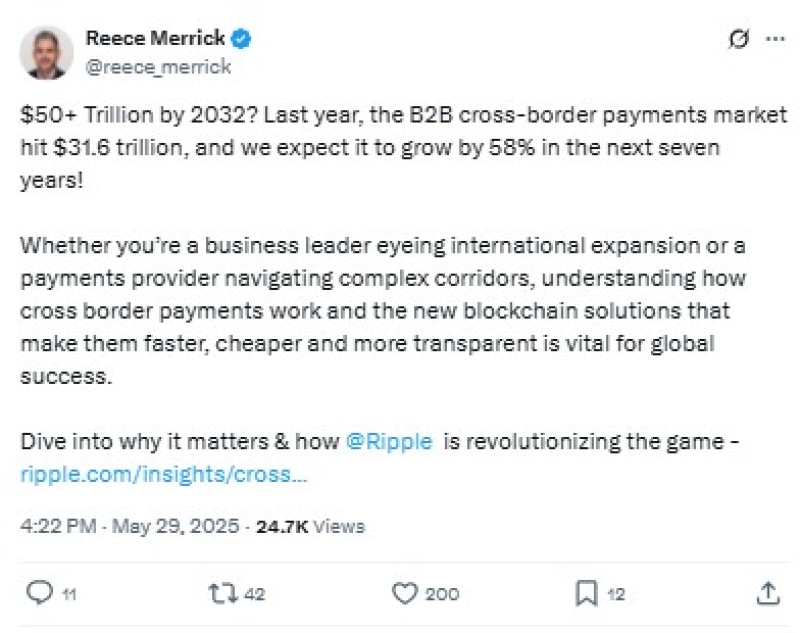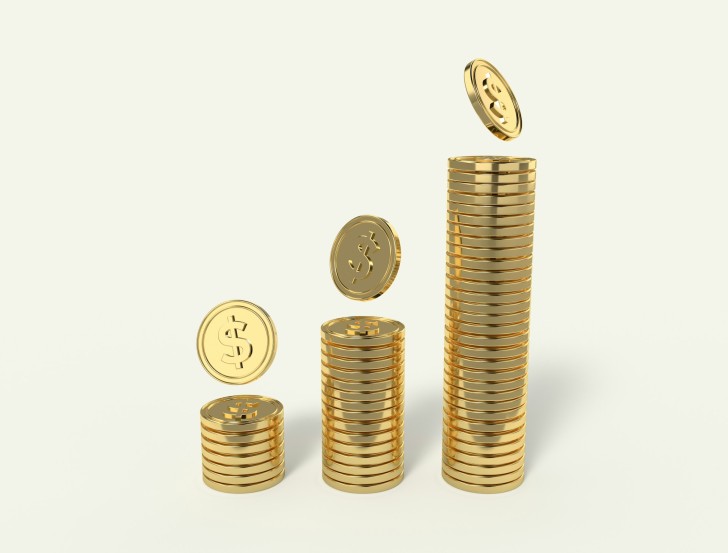A top Ripple exec just made a prediction that's got crypto traders buzzing: cross-border payments could hit $50 trillion by 2032, and XRP is perfectly positioned to ride this wave.
Why This $50 Trillion XRP Opportunity Is Actually Real (Not Just Hype)
Okay, so here's what happened. Reece Merrick - this guy runs Ripple's whole Middle East and Africa operation - just posted on X about something pretty wild. He's saying the cross-border payments market is about to absolutely explode from $31.6 trillion last year to over $50 trillion by 2032. That's 58% growth in seven years, which is honestly insane when you think about it.

But wait, before you roll your eyes and think "another crypto exec making crazy predictions," let me tell you why this one's different. Ripple isn't some random startup hoping to get noticed. These guys already handle over 90% of the global financial exchange market through their payment network. When someone who's literally in charge of moving billions of dollars around the world makes a prediction like this, you probably want to listen.
The numbers actually make sense too. E-commerce hit $6 trillion globally in 2024, and more of that is happening across borders every day. Every time you buy something from Amazon that ships from China, or when a small business orders supplies from overseas, that's a cross-border payment. And all those transactions need to move through someone's network.
Here's where it gets interesting for XRP holders: Ripple's network can handle payments in both XRP and regular fiat currencies. So whether this growth comes from crypto adoption or just more traditional cross-border business, Ripple's positioned to benefit either way. It's like they've got a bet on both horses in the race.
RLUSD Is Quietly Becoming the Sleeper Hit Alongside XRP
While everyone's been obsessing over XRP's price movements (it's sitting around $2.31 right now, by the way), Ripple's been building something else that could be even bigger. Their RLUSD stablecoin launched in December and it's already sitting at around $244-250 million market cap. That might not sound huge compared to USDT or USDC, but here's the thing - it's grown 87% in just the past month.
What's really smart is how they're rolling this out. RLUSD just got added to Euler for lending and borrowing, Bitget started trading it, and BitMEX became the first exchange to let you use it as margin. That's not random - that's strategic. They're building the infrastructure so businesses can actually use this thing for real payments, not just trading.
Think about it from a business perspective. If you're a company that needs to send money overseas, you've got two options with Ripple now. You can use XRP if you want speed and don't mind some price volatility, or you can use RLUSD if you need price stability. It's like having both a Ferrari and a Honda Civic in your garage - each one's perfect for different situations.
The really interesting part is that Ripple processed $70 billion in payments just in Q4 of 2024. Now they're adding RLUSD to that mix, which means businesses have even more reasons to use their network instead of traditional banking. And every transaction that flows through their system potentially creates demand for either XRP or RLUSD.
XRP Price Could Go Absolutely Bonkers If This Prediction Plays Out
Here's where things get spicy for XRP traders. Some analysts are throwing around price predictions of $5.05 by the end of 2025, with long-term targets as high as $26.50 by 2030. Now, I'm not saying those numbers are guaranteed - crypto predictions are about as reliable as weather forecasts sometimes. But the logic behind them isn't completely insane.
Here's the math that's got people excited: if cross-border payments really do grow from $31.6 trillion to $50 trillion, and Ripple keeps or grows their market share, the demand for XRP liquidity could go through the roof. More transactions mean more need for the asset that makes those transactions work smoothly and cheaply.
What makes this different from other crypto moonshot predictions is that Ripple's already got real adoption. They're not hoping banks will use their technology someday - banks are already using it. The G20 recently identified Ripple's blockchain payment tech as crucial for meeting their cross-border transaction goals. When world leaders are talking about your crypto as part of their official financial strategy, that's not speculation anymore.
The timing is pretty perfect too. While other crypto projects are still trying to figure out regulatory compliance, Ripple's been dealing with that stuff for years. They've got clarity in most major markets, partnerships with actual financial institutions, and now they're adding stablecoin capabilities on top of XRP.
Look, nobody knows exactly how high XRP could go if this $50 trillion market materializes. But here's what we do know: Ripple's not just another crypto company throwing around big numbers and hoping for the best. They're already moving serious money for real businesses, they've got the regulatory backing to keep growing, and they're building infrastructure that makes sense for both crypto natives and traditional finance.
Whether XRP hits $5, $26, or something completely different, the underlying trend is clear. Money is going to keep moving across borders, and it's going to keep growing. Ripple's positioned to capture a chunk of that growth, and XRP holders get to come along for the ride. In a market full of projects that are all promise and no delivery, that's actually pretty refreshing.
 Peter Smith
Peter Smith

 Peter Smith
Peter Smith


